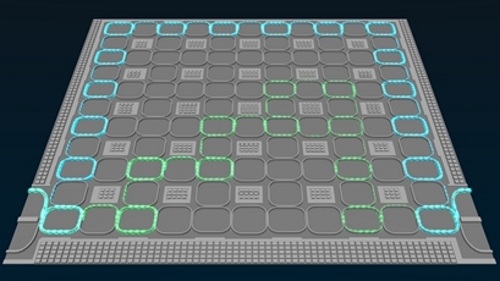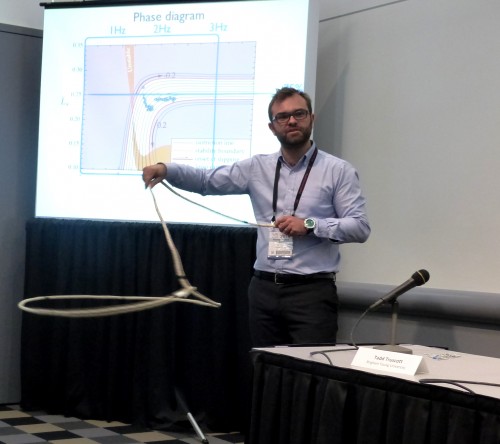Tag archives: quantum physics
Once upon a time…the art of telling a good quantum tale
By Tushna Commissariat
It’s been nearly two weeks since I spent three intense and interesting days in Sweden bundled into a classroom with other journalists and scientists to polish up our knowledge of all things quantum. Since attending the NORDITA science-writing workshop, I have spent a lot of time thinking about one of the main themes of the meeting: “What is the best way to communicate quantum physics to the public?”
What can you learn at a quantum ‘boot camp’?
By Tushna Commissariat in Stockholm, Sweden
Google the word “quantum” and take a look at what comes up.

In addition to the obvious news articles about the latest developments in the field and the Wikipedia entries on quantum mechanics, you’ll undoubtedly come across a heap of other, seemingly random, stories.
I found, for example, a David Bowie song being compared to a quantum wavefunction (by none other than British science popularizer Brian Cox), as well as a new cruise ship being named Quantum of the Seas. Then there’s the usual jumble of pseudo-scientific “wellness” therapies that misguidedly adopt the word in a strange attempt to give their treatments some sort of credibility.
So while it seems that everyone is talking about quantum something or other, how much do we really understand this notoriously difficult subject? More to the point, how much do science journalists, like me, really know about the subject? I write stories about quantum mechanics from time to time for Physics World and the subject can, I assure you, be fiendish and quite mind-bending.
Shining a brighter light on topological transport

Topological light travels easily around the edge of the lattice, yet it gets muddled in the middle. (Courtesy: JQI)
By Hamish Johnston
Last year we reported on a fascinating experiment that simulated the quantum Hall effect using light. Mohammad Hafezi and colleagues at the Joint Quantum Institute (JQI) of the University of Maryland created a lattice of ring-shaped silicon waveguides that are placed just nanometres apart (see image above). This allows light in one ring to “tunnel” into a neighbouring ring and make its way across the matrix, hopping from ring to ring.
View all posts by this author | View this author's profile
Robotic cowboys and clams, the SQUID at 50 and more

Pierre-Thomas Brun shows off his lassoing skills.
By Tushna Commissariat at the APS March Meeting in Denver
It has been another exceedingly busy day the APS March Meeting – there were sessions on the SQUID’s many applications, robotic clams, global health physics and the spread of epidemics, and even some toys based on physics principles. Here’s another quick round-up of the fascinating talks.
On SQUID row
It’s the 50th birthday of the superconducting quantum interference device or SQUID – a very sensitive magnetometer that accurately measures extremely subtle magnetic fields – this year, and there were sessions this morning to discuss its impact to date as well as possible future applications. Kent Irwin from Stanford University discussed how superconducting photon detectors that are used in a host of astronomical and cosmological observations are being amplified using SQUIDs. Such SQUID-boosted sensors are being used to make more accurate measurements of the cosmic microwave background (CMB) – to look at its power as well as certain polarizations modes it exhibits. As certain experiments look for signs of gravitational waves in in the CMB polarization, this could be particularly helpful.
View all posts by this author | View this author's profile
Cruise-ship physics, the many ways to tie a tie, shaken-up carbon dating and more
By Tushna Commissariat
If you like piña coladas and quantum mechanics, then we hope you are currently on the two-week “Bright Horizons 19” Southeast Asia cruise, as on board is physicist and writer Sean Carroll. He will be giving multiple lectures over the next 15 days on everything from the Higgs boson to dark matter and other fundamentals of quantum mechanics. Also floating along with Carroll are other lecturers who will cover topics from natural history to genetics to military strategy. If, like us, you are stuck at home, you can take a look at Carroll’s slides on his blog, maybe have a cocktail while you are at it.
View all posts by this author | View this author's profile
Quantum Cheshire cat spotted in Grenoble

A most curious thing is the quantum Cheshire cat. (Courtesy: iStockphoto/koffeezilla)
By Hamish Johnston
Three months ago we ran a news article about a “quantum Cheshire cat” experiment that was proposed by Yakir Aharonov of Tel Aviv University and colleagues. Now, an international team of physicists has created a quantum Cheshire cat using polarized neutrons at the Institut Laue-Langevin (ILL) in Grenoble, France.
The work was done by Yuji Hasegawa and colleagues at the Vienna University of Technology, ILL, the University of Cergy-Pontoise and Chapman University.
View all posts by this author | View this author's profile
Now you see them, now you don’t…

Spannungsfeld by Julian Voss-Andreae is set to be installed at the University of Minnesota next month.
By Matin Durrani
I don’t know if they’re going to be dubbed “Alice” and “Bob”, but those names seem fairly appropriate for the two new figures – one male, one female – that make up the latest artwork from the German-born quantum-physicist-turned sculptor Julian Voss-Andreae.
Set to be installed at a new physics and nanotechnology building at the University of Minnesota in Minneapolis-St Paul, the work is officially titled Spannungsfeld – a German term that literally means “tension field” and which implies, according to Voss-Andreae, a “dynamic tension, often between polar opposites, that permeates everything in its vicinity”.
View all posts by this author | View this author's profile
Nuclear-explosion survival tips, gravity-defying beads, big questions and more
By Tushna Comissariat
Would you know exactly where to run and shelter in the event of nuclear fallout in your city? Would it be best to stay where you are or move, and for how long should you stay inside before venturing out into your post-apocalyptic world? If these questions have plagued your mind, you can now turn to a new model developed by Michael Dillon, an atmospheric scientist at the Lawrence Livermore National Laboratory in California, US. Dillon’s practical model outlines simple ideas and suggestions that the average person – without advanced equipment and know-how – could apply in the event of a low-level nuclear attack, which is the most plausible type likely to take place in today’s political climate. You can read all about about the model on both the io9 website and in Science magazine, and then map out your perfect route.
Spies are keen on quantum computing, claims Washington Post
By Hamish Johnston
An article in the Washington Post claims that the US National Security Agency (NSA) is funding research into how quantum computers could be used to crack cryptography systems. While the article claims to be based on leaked secret documents, the revelation doesn’t seem to surprise several of the physicists quoted in the piece.
Scott Aaronson of the Massachusetts Institute of Technology (MIT) says that it’s unlikely that the NSA project is much further ahead of public quantum-computing research. His MIT colleague Seth Lloyd adds that it could be five years or more before the NSA or anyone else creates a quantum computer capable of breaking cryptographic systems.
Interestingly, Lloyd alludes to a space-race-like rivalry between the US, EU and Switzerland that is driving the development of code-busting quantum computers.
Lateral Thoughts: some things never change
By Margaret Harris
This is the second in a series of blog posts about “Lateral Thoughts”, Physics World’s long-running humour column. You can read the first one here.
The Lateral Thoughts column of humorous, off-beat or otherwise “lateral” essays has been part of Physics World ever since the magazine was launched in October 1988. In my previous post about the column’s history, I described some ways that Lateral Thoughts have changed since the early days (tl;dr version: loads of sexism, side order of class conflict). But in my trawl through the archive, I’ve also discovered that some things haven’t changed very much at all over the past quarter-century.
View all posts by this author | View this author's profile